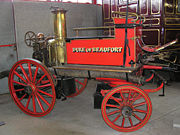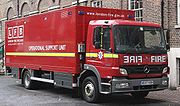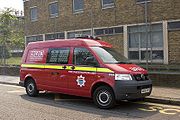
Fire appliances in the United Kingdom
Encyclopedia

Fire service in the United Kingdom
The fire services in the United Kingdom operate under separate legislative and administrative arrangements in England, Northern Ireland, Scotland and Wales...
fit into several distinct categories and perform a wide range of general and specialised roles.
Modern day fire appliances are technologically-advanced machines compared to the steam-powered ones of a hundred years ago. The modern appliance is capable of carrying a multitude of equipment and firefighting media (such as water and foam) to deal with different types of emergencies ranging from fire
Fire
Fire is the rapid oxidation of a material in the chemical process of combustion, releasing heat, light, and various reaction products. Slower oxidative processes like rusting or digestion are not included by this definition....
s, rescue
Rescue
Rescue refers to responsive operations that usually involve the saving of life, or prevention of injury during an incident or dangerous situation....
s, vehicle extrication
Vehicle extrication
Vehicle extrication is the process of removing the vehicle from around a person that has been involved in a motor vehicle accident, when conventional means of exit are impossible or unadvisable. A delicate approach is needed to minimize injury to the victim during the extrication...
, flood
Flood
A flood is an overflow of an expanse of water that submerges land. The EU Floods directive defines a flood as a temporary covering by water of land not normally covered by water...
s, salvage, casualty and trauma care; not just pumping water.
The design and size of a fire appliance depends very much upon the role it is expected to perform. In general, most fire and rescue services utilise a standardised range of vehicles and equipment. However, airport fire services
Airport Rescue and Firefighting Services in the United Kingdom
The provision of Rescue and Firefighting Services at all airports and aerodromes in the United Kingdom is a requirement under British Law and International agreements set out by the International Civil Aviation Organization....
tend to use much larger and heavier appliances than those typically deployed by public fire services
Local Authority Fire Service
In the United Kingdom the terms Local Authority Fire and Rescue Service, County Fire & Rescue Service or Public Fire and Rescue Service refer to a fire and rescue service provided and operated by a county or metropolitan council to serve the public in an emergency...
.
Common UK fire appliance manufacturers and suppliers include Dennis
Dennis Specialist Vehicles
Dennis Specialist Vehicles is a major British coachbuilder and manufacturer of specialised commercial vehicles based in Guildford, England...
, Scania, Volvo
Volvo
AB Volvo is a Swedish builder of commercial vehicles, including trucks, buses and construction equipment. Volvo also supplies marine and industrial drive systems, aerospace components and financial services...
, HCB Angus, JDC, EmergencyOne and Carmichael. Most front line fire appliances in the UK are marked in high conspicuity red and yellow battenburg markings
Battenburg markings
Battenburg refers to a pattern of high-visibility markings used to maximise conspicuity, primarily used on vehicles of the emergency services, but also in other applications such as uniforms...
, and are fitted with blue lights and sirens
Blues and twos
Blues and twos is a colloquial British term that refers to the emergency vehicle equipment of combined flashing lights as well as sirens that the emergency services in the UK and Ireland use when responding to an incident...
. Many appliances have roller shutter doors revealing compartments housing various items of equipment.
Public fire and rescue services
Public fire and rescue servicesLocal Authority Fire Service
In the United Kingdom the terms Local Authority Fire and Rescue Service, County Fire & Rescue Service or Public Fire and Rescue Service refer to a fire and rescue service provided and operated by a county or metropolitan council to serve the public in an emergency...
are those operated by fire and rescue authorities, and funded by council tax.
Most fire appliances used by them are referred to as "domestic" type appliances to differentiate them from larger airport crash tender
Airport Crash Tender
An airport crash tender is a specialised fire engine designed for use at aerodromes and airports in aircraft accidents.Airport Crash Tenders are extremely powerful machines...
s. They are normally based on truck chasis and weigh over 12 tonnes, meaning they require an LGV license to be driven. Some brigades use slightly smaller appliances based on GVW of 7.5 tonnes, which do not require an LGV license. They are common in rural brigades where narrow lanes and rough terrain would be difficult for a larger fire engine to negotiate.
Rescue Ladder / Pump Ladder / Water Rescue Tender
The most common front line appliance deployed to all emergency calls goes by a variety of names, including Rescue Ladder, Pump Ladder, Water Rescue Tender, or slight variations on those names.It is a general purpose unit capable of carrying and pumping water, carrying rescue and cutting equipment to deal with road traffic accidents and other rescue operations, a large ladder (for example 13.5m) and several smaller ladders and roof ladders.
The appliance also carries breathing apparatus, lighting, tools, trauma care packs, water rescue gear, lines (ropes), hoses, and possibly chemical protection suits and foam. The vehicle will be crewed by four to six firefighter
Firefighter
Firefighters are rescuers extensively trained primarily to put out hazardous fires that threaten civilian populations and property, to rescue people from car incidents, collapsed and burning buildings and other such situations...
s.
Water Ladder / Water Tender
A Water Ladder or Water Tender is very similar to the aforementioned appliance, however with less emphasis on rescue gear and will usually carry a smaller ladder (for example 9m or 10.5m).It is normally mobilised to augment and support the initial appliance or to respond to secondary, less urgent incidents. It is crewed by four to six firefighters.
Hydraulic Platform
A Hydraulic Platform (HP) is a large appliance used for effecting rescue from high-rise structures.It is essentially a large crane fitted with a caged platform which can be hoisted to heights well over 30m in some cases. The platform may be raised to windows or balconies to rescue stranded persons.
The appliance is also capable of pumping water and as such occasionally these units are also used to direct hose reel water jets into a fire from an elevated position.
Turntable Ladder
A Turntable Ladder (TL) is similar in appearance to a HP, however with a primary difference of instead of having a caged platform the TL is simply a large telescopic ladder, which can still be used to effect rescues from tall structures and pump water.Aerial Ladder Platform
An Aerial Ladder Platform (ALP) is designed to deploy an elevated master stream of water,or to provide a method of rescuing trapped persons, the 'knuckle' design of the arm of an ALP means that it is very manouverable for rescue situations. The ALP also has a set of ladders alongside the main boom that can be used for access or escape in the case of boom failure while at height. The ALP has become the most common type of aerial appliance found in the UK since it's widespread introduction in the late 1980s.Light Four-Wheel Drive Pump
Light Four-Wheel Drive Pumps (L4P) are a smaller version of the front line fire engine. They are usually used in rural locations where they can more easily negotiate tough terrain, narrow streets or remote access to certain areas.They ordinarily carry a condensed quota of the equipment usually found on a normal-sized fire engine.
Light Two-Wheel Drive Pumps (L2P) may also be used.
Rescue Tender
A Rescue Tender (RT) is a generic term for any fire appliance which carries out a "heavy" or "specialist" rescue role.The equipment it carries varies depending on where it is deployed. It may carry heavy-duty cutting equipment for use at road traffic collisions or other transport incidents.
Water rescue
Swiftwater rescue
Swiftwater rescue is a subset of technical rescue dealing in whitewater river conditions. Due to the added pressure of moving water, swiftwater rescue involves the use of specially trained personnel, ropes and mechanical advantage systems that are often much more robust than those used in standard...
and confined space rescue
Confined space rescue
Confined space rescue is a subset of technical rescue operations that involves the rescue and recovery of victims trapped in a confined space or in a place only accessible through confined spaces, such as underground vaults, storage silos, storage tanks, or sewers.Confined space rescues can be...
gear may also feature, as well as extensive lighting equipment and pneumatic airbags to lift heavy loads.
Operational Support Unit

The term is interchangeable with other support appliances such as HazMat and chemical support, breathing apparatus tenders, hose layers, damage control tenders or decontamination units.
An OSU carries equipment to support normal fire appliances and crews, typically at prolonged or major incidents.
Breathing Apparatus Tender
Breathing Apparatus Tenders (BAT) carry extensive stocks of spare breathing apparatus (BA) cylinders at large incidents. They replenish cylinders which may have been used by firefighters tackling a protracted blaze or dealing with Hazardous Materials.Some BATs are also fitted with compressors which allow empty BA cylinders to be recharged on scene. Most also contain a mobile workshop so that BA sets can be repaired at the scene of incident so that they can be made available for use again at the incident within in a very short space of time.
HazMat / Scientific Support Unit / Decontamination Unit

Decontamination Units carry specialised equipment capable of decontaminating emergency workers and/or members of the public who have come into contact with HazMats. The equipment carried is wide-ranging and highly technical in nature.
Command Unit
The advancement of technology and potential for very large-scale incidents has led to more fire services utilising or increasing their use of mobile Command Units.A fundamental advantage of such an appliance is to accommodate the many different types of communication equipment needed at major incidents. In addition to the wide range of radio frequencies used, fire chiefs often need to communicate via landlines and send and receive information via satellite links and CCTV of the ongoing situation.
The command vehicle can essentially be used as an on-site conference centre for command personnel, mapping and planning firefighting operations and booking-in and directing crews as they arrive.
Water Carrier
Water Carriers (WrC) are tankers that are used to provide vast volumes of water to locations that may not have a nearby hydrant or open water supply. In some Fire and Rescue Services they also double as Foam Tenders.Foam Tender
Foam Tenders (FoT) carry large amounts of foam to be used at incidents where water is ineffective or cannot be used to tackle a blaze. They may take the form of a tanker, or a lorry carrying foam packets or barrels. In some Fire and Rescue Services, Water Carriers serve as Foam Tenders, by dumping their regular load of water and replacing it with foam.Welfare Unit / mobile canteen
At large protracted incidents firefighters may be subjected to physically arduous work in inhospitable situations such as extreme heat. As such the welfare of firefighters is taken very seriously and ability to provide refreshments to sustain hydration and energy levels is paramount. This is where a Welfare Unit is mobilised.Fire Investigation Unit

Some brigades may also utilise specially-trained search dogs. At the scene of incidents, the dog wears specialist protective 'fire wellies' on his or her paws to guard against injuries from broken glass or hot material. The dogs can detect minute quantities of hydrocarbon accelerants within minutes. This procedure would normally take a human investigator - using specialist equipment - much longer, before samples can be taken away for scientific analysis.
New Dimension vehicles
New DimensionNew Dimension programme
The New Dimension programme, sometimes referred to as the New Dimension or New Dimensions, was started by the Department for Communities and Local Government in the UK, for fire and rescue services in England and Wales, following the 2001 terror attacks.It has provided equipment, training and...
vehicles are large curtain-side trucks designed to be deployed at incidents involving CBRN materials or for urban search and rescue
Urban search and rescue
Urban search and rescue involves the location, extrication, and initial medical stabilization of victims trapped in confined spaces due to natural disasters, structural collapse, transportation accidents, mines and collapsed trenches.USAR teams in different countries may be organised in a...
(USAR) use at the scenes of natural or large scale disasters.
They do not pump water, but instead carry vast quantities and stocks of mass decontamination equipment, scene lighting, chemical protection kits, environmental protection equipment and general purpose rescue equipment. They are always on standby to be deployed if local resources may be overwhelmed.
The New Dimension vehicles are owned by the government, rather than the fire and rescue service and are stationed at strategic locations throughout the UK.
High Volume Pumps

They were used to great effect and in vast scale to assist operations at the Buncefield fire in Hertfordshire
Hertfordshire
Hertfordshire is a ceremonial and non-metropolitan county in the East region of England. The county town is Hertford.The county is one of the Home Counties and lies inland, bordered by Greater London , Buckinghamshire , Bedfordshire , Cambridgeshire and...
in 2005 and nationwide flooding in 2007
2007 United Kingdom floods
The 2007 United Kingdom floods were a series of destructive floods that occurred in various areas across the country during the summer of 2007. The most severe floods occurred across Northern Ireland on 12 June; East Yorkshire and The Midlands on 15 June; Yorkshire, The Midlands, Gloucestershire,...
.
Motorcycles
In July 2010, the Mersyside fire service began a six month trial of two fire bikesFire bike
A fire bike is a motorcycle used by a fire department. Several countries around the world use fire bikes, often to beat traffic congestion, and the equipment carried ranges from simple extinguishers to jet guns with hose rigs...
to be used to fight small fires, freeing up main appliances. Merseyside has also deployed other bikes for various uses since 2005. Several fires services of the UK use fire bikes not for firefigthting, but as motorcycle road safety awareness tools, alongside initiatives such as BikeSafe.
Airport rescue and firefighting services
Ministry of Defence Fire Services
The Defence Fire and Rescue ServiceDefence Fire and Rescue Service
The Defence Fire and Rescue Service is the primary firefighting and rescue service protecting British defence estates and property. Along with the Royal Air Force Rescue and Firefighting Service it forms the Ministry of Defence Fire Services.-History:...
and RAF Rescue & Firefighting Service operate numerous types of appliances, ranging from domestic-type tenders to airfield crash tenders, depending on the location they are serving.
Industrial and private fire and rescue services
Industrial and private fire and rescue services use several types of appliances depending on the type of cover provided. Large oil refineriesOil refinery
An oil refinery or petroleum refinery is an industrial process plant where crude oil is processed and refined into more useful petroleum products, such as gasoline, diesel fuel, asphalt base, heating oil, kerosene, and liquefied petroleum gas...
may have their own on site Fire Service whom deploy large bulk foam tenders to deal with major oil fires. Domestic type fire appliances are most commonly used.

